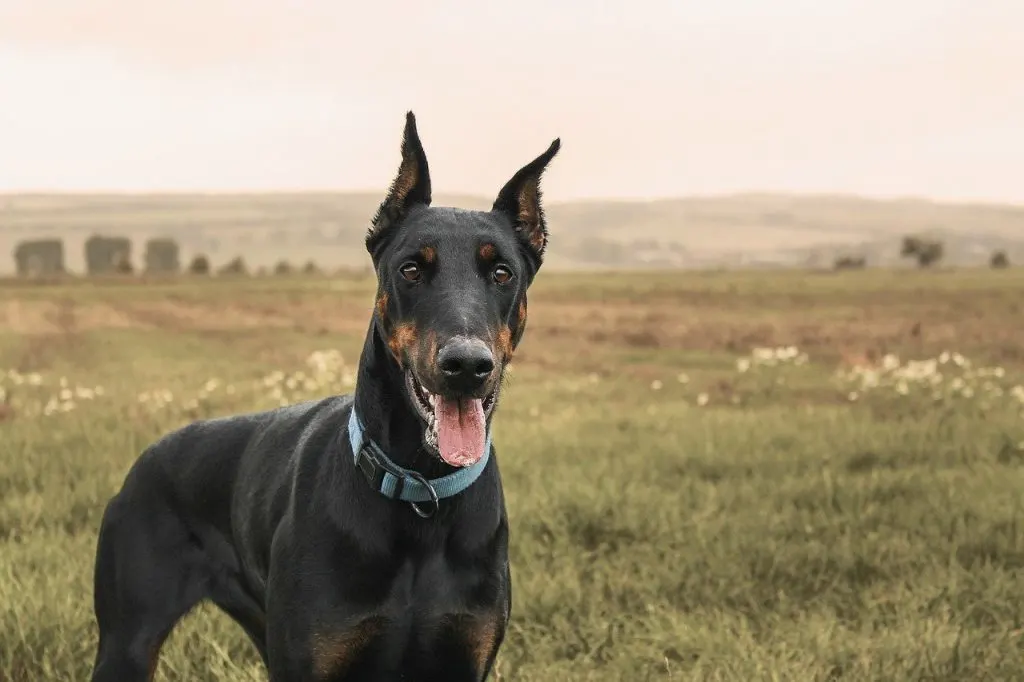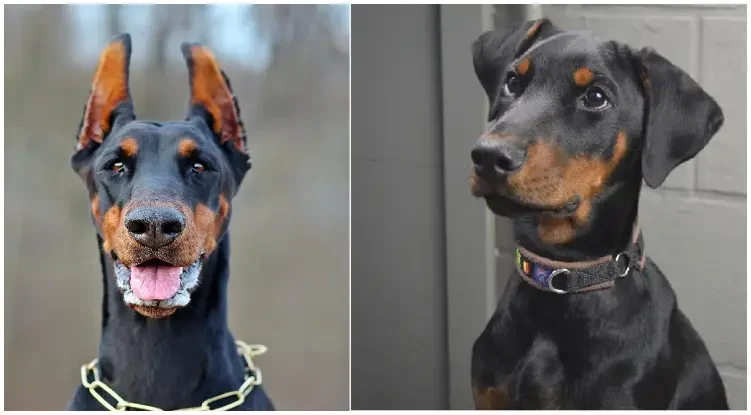You probably have already heard of Dobermans. We all know these canines for their slim, elegant yet muscular, and strong appearance. Their pointy, erect ears give them even more of an intimidating appearance. But, did you know that not all Dobermans look like that? Have you ever seen a Doberman with uncropped ears? Dobermans get that look due to ear cropping. This breed is born with cute floppy ears, but many people decide to have their dog’s ears cropped. There are other surgical alterations dog owners do to their canines, like tail docking. But why do they do that?
Well, for some breeds that have become the breed standard, it is one trait that we recognize them by. In the case of the Doberman it´s cropped ears, for other breeds it´s a docked tail.
But, in this article, we´ll take a closer look at why some owners do that to their dogs. Of course, we´ll also talk more about ear cropping in Dobermans, how it affects these dogs and if there is any way to stop it. So, keep on reading!
Read some of our other articles:
- Micro Bully: Why they’re usually a scam
- Brindle Pitbull Dog: Everything That You Should Know
- Cane Corso Blue: The Rare And Mystery Cane Corso
- Onofrio Dog Shows: Everything That You Should Know
- Cane Corso Dogo Argentino Mix
- Doberman Pitbull Mix: Best Of Both Worlds?
- Bordoodle: The Intelligent And Energetic Doodle
- Should I Wake Up My Puppy To Pee At Night?
- Lycan Shepherd: A mix of three breeds
- Tibetan Mastiff: A Protective & Fearless Giant
History of the Doberman breed
Before there was Doberman ear cropping, someone had to develop the Doberman breed. That´s logical. But who created this breed and why?
Fun fact: Every breed used to be a mix of several different breeds. That´s the only way to develop a new breed. By combining existing breeds.
The Doberman breed was bred in Germany in the 1890s. The story of how this breed came to life is a rather interesting one. The man who created this breed was called Friedrich Louis Dobermann. Louis was a tax collector, and he wanted to create a dog breed to help him with his then risky job.
Louis lived in the Thuringia district in Germany, and he was in charge of taxes. To be more precise, he was a tax collector. It’s needless to say that the job he performed was very dangerous. Especially because there were bandits in the area who would do anything to get a hold of the money he carried with him. They could attack him as he went around the area.
But, Dobermann wasn’t only a tax collector, he did another job. He was also the dog catcher in his town. So, he often took a dog with him to protect him. But after some time he decided he needed a specific dog, a dog that will be loyal and protect him from whoever wanted to harm him. so started making dogs with the idea of having a loyal friend and protector in mind, and after some trial and error he came up with the early Pinscher.
Fun fact: The Doberman got its name after Friedrich Louis Dobermann, because of his work on the breed.
We don’t know what dogs he used to make the breed, but many believe that the breeds are Rottweiler, German Pinscher, and Black and Tan Terrier are some of the mixed dogs. Louis presented the first Doberman to the world in 1876, and people were very excited about him.
Sadly, Louis died in 1894, and when he did, he took with him all the knowledge of the breeds that he combined to make the first Dobermann.
At the end of the 19th century, the German breeders who kept up with Dobermann’s work were more concerned with how their dogs worked than how they looked. It was their goal to make the Doberman into a “super dog.” At first, they only bred dogs that were brave, smart, quick, and tough. They almost did too well. The breed was known for its strength and anger.
It was like that until breeder Otto Goeller came along. He made the Doberman more usable, he made them more domesticated. In 1900, the German Kennel Club made the Doberman Pinscher a breed.
Where do breed standards of Dobermans fit in with ear cropping?
Let´s talk about the appearance of Doberman Pinschers, how they look today, basically what the breed standard for them is. Now, who could tell us better what a Doberman Pinscher has to look like than the American Kennel Club?
According to the AKC, these are the traits a Doberman needs to possess to be recognized by this kennel club:
The appearance is that of a dog of medium size, with a body that is square Compactly built, muscular and powerful, slim dogs, known for great endurance and speed. Elegant in appearance, of proud carriage, reflecting great nobility and temperament. Energetic, watchful, determined, alert, fearless, loyal, and obedient.
Now, this is only the general appearance and temperament of the Doberman Pinscher, let´s dive in a bit deeper. We´ll only focus on the head for now.
The head is long and dry, resembling a blunt wedge in both frontal and profile views. When seen from the front, the head widens gradually toward the base of the ears in a practically unbroken line. Eyes almond-shaped, moderately deep-set, with vigorous, energetic expression. Iris, of uniform color, ranging from medium to darkest brown in black dogs; in reds, blues, and fawns the color of the iris blends with that of the markings, the darkest shade being preferable in every case. Ears normally cropped and carried erect. The upper attachment of the ear, when held erect, is on a level with the top of the skull.
If you pay closer attention you´ll see that the description says “Ears normally cropped and carried erect.” But why normally? Well, because that isn´t the standard in the whole world, some countries forbid it. Many places have banned ear cropping entirely, including most European countries.
In the US it´s not completely forbidden, but certain regulations need to be followed.
According to the American Veterinary Medical Association, there are currently nine states that specifically regulate ear cropping of dogs:
Connecticut, Maryland, New Hampshire, New York, and Pennsylvania all prohibit ear cropping except by a licensed veterinarian while the dog is under an anesthetic. Maryland law also stipulates that the ear cropping must be “appropriate on the animal”. Illinois prohibits animal torture but makes an exception for alteration of an animal done under the direction of a licensed veterinarian. Maine prohibits mutilating an animal by irreparably damaging body parts but makes an exception for conduct performed by a licensed veterinarian. Massachusetts prohibits ear cropping except when performed by a licensed veterinarian and Washington prohibits ear cropping except when it is considered a customary husbandry practice.

As you can see, it is allowed to be done, but only by veterinarians. But, that´s where it gets interesting, not all vets are for this procedure, many are for the Doberman uncropped ears look. in the next section, we´ll see what vets think of ear cropping.
In North America it´s a bit different, there animal rights activists want the ear cropping procedure to become illegal!
What do veterinarians think?
As you could see, in the majority of US states only veterinarians can perform ear cropping on dogs. The reason why this topic is so much controversy this topic is that more and more vets are refusing to do this procedure and are speaking out about why it´s so wrong! We´re not kidding, they are speaking out against it. There is even a study about this issue, but more on that in the next section. For now, let´s only focus on the fact that veterinarians are against this procedure.
Ear cropping in dogs is elective surgery, meaning an owner can choose if he will do that to his dog or not. It is a cosmetic procedure that changes the shape of a dog’s ears a lot, but despite the belief that it helps the dog, it doesn’t. Realistically speaking it has very little benefits to the dog.
Because of that, both the American Veterinary Association (AVMA) and the Canadian Veterinary Medical Association are against surgical alterations that are not for the benefit of the dog and only for cosmetic purposes. They are against all surgical alterations that alter the natural state of a dog. For you to better understand how outdated this practice is we´ll tell you that there are fewer veterinarians in the US who will perform this surgery. Ear cropping isn´t even being taught at colleges of veterinary medicine or veterinary schools anymore. All of them agree that keeping a dogs ears in their natural form is the best option for them.
How does Ear Cropping Surgery Look like and why is it done?
Ear cropping is a straightforward surgical procedure that only serves cosmetic purposes. In that procedure, a vet will remove a part of your Doberman’s ears.
In most cases, this procedure is done when dogs are 8 to 12 weeks old. After 12 weeks the cartilage in the ear will have hardened and this makes it unlikely that the ears will ever stand erect. The posts remain in the puppy’s ears until the ears will stand erect on their own. Once their ears are trimmed, the doctor stitches the edges and tapes the ears to a hard surface. The ears stay like that until the wound is completely healed. The entire operation is done under anesthesia and it takes only half an hour. But, sometimes the surgery doesn´t end as planned and the dog needs additional surgery, which is even more painful than you can imagine.
Taking care of the cropped ears
After the operation, the owners have to take extra good care of their dog’s ears. Infections are pretty common so good hygiene is a must. The healing process is pretty tough, so chances are that your dog will be in pain. Doberman ear posting can take from a few weeks up to a year.
Of course, the healing process depends on the style of crop your dog gets. Ear cropping styles are:
- short crop,
- medium crop,
- longer crop which is the standard show crop.
As for the reason why some dog owners choose to do that it´s to their dog to cut down on the chances of getting an ear infection by making the ear canal more ventilated. Basically to lower the chance of health issues. But the truth is it’s highly debated whether cropping the ears or leaving the ears droopy reduces the risk of getting an ear infection. But, let´s be real, the majority of owners do it for looks. It´s become so normal to crop a dog´s ears that it´s almost impossible to see a Doberman with intact ears.
Scientific studies on ear cropping and tail docking
There are numerous studies on this topic, but we will talk about a study by Katelyn Mills, a graduate student at the University of British Columbia, grew interested in the topic of medically unnecessary animal surgeries. According to her, she noticed that surveys on the procedures were based on veterinarians’ and breeders’ opinions of them and Doberman uncropped ears. She wondered how ordinary people perceived them.
The first thing, Mills and her team asked 810 people who were all Americans to look at a picture of a Doberman that had its ears and tail cut and docked, as well as pictures of three other breeds that had their ears and tails cut and docked, like the Boxer, the miniature Schnauzer, and the Brussels Griffon. a list of 10 traits, such as the color of the dog’s fur and the number of teeth, and asked to rate how likely those traits were to be hereditary or caused by humans. Most study participants said that dogs were born with short tails and erect ears.
Marina von Keyserlingk, Mills´s professor and co-author of the study, said she thinks the results indicate that many people have come to accept dogs’ typical appearances at face value, not as products of centuries of human decisions.
Mills on the other hand believes that the lack of awareness could be intentional:
People disconnect themselves from things if they find them uncomfortable. They don’t want to know about it.
Another uncomfortable topic is tail docking. Dogs communicate with their tails, so why cut off a dog´s ability to show its feelings to us and other dogs? And experts even prove that point, Julie Hecht, a canine science blogger for Scientific American claims the following:
In intraspecific communication, it’s important to have all the body parts. The tail is an instrumental part of this whole communicative repertoire.
Doberman uncropped ears: How do they look like?
Naturally, the ears of a Doberman are long and floppy. Most people wouldn’t even recognize a Doberman with uncropped ears. In some parts of the world, like Germany and Austria, ear cropping is banned. Dobermans with uncropped ears are there pretty common.

Like we already explained, Dobermans have naturally floppy ears. Breeders initially started cropping them so that dogs could hear better. Back then many believed that if a dog’s ears were cropped they could hear more clearly. As Dobermans are a guarding breed, that’s important for them.
However, later studies were pretty inconclusive. Even if ear cropping does improve hearing, it does so only slightly.
Should I crop my Doberman’s ears or go for the Doberman uncropped ears look?
The short answer is — no you shouldn’t crop your dogs ears. There isn’t any valid reason to do so. It’s not mandatory and it’s even banned in many countries. It does not have any health benefits and no true purpose. The only reason why breeders still do it is for the aesthetic.
Even if this procedure isn’t yet banned in your country, chances are that it’s still controversial. While the American Kennel Club considers ear cropping essential for the breed’s integrity, the American Veterinary Medical Association is against cosmetic surgical procedures. They believe surgeries such as ear cropping are an unnecessary health hazard.
Either way, one sure thing is that ear cropping is losing its popularity all over the world. It isn’t even being taught in many vet schools. And many vets will refuse to do this procedure, even if it isn’t banned in your country.
Final verdict: Doberman natural ears/Doberman uncropped ears
Dobermans are popular dogs and people all around the world love them. But there is one question many ask: to keep the Doberman natural ears or not?
Like we already explained, Dobermans are naturally born with long and floppy ears and long tails. They are active dogs and generally a very healthy breed. There isn´t a good enough reason to support ear cropping or having it done to your dog. We know that it´s unusual, but uncropped ears exist on Dobermans!
Some breeders decide to crop their ears once the puppy is between 8 and 12 weeks old. While it was believed that this improves the hearing ability of canines, that simply isn’t true. Dobermans were originally bred as guard dogs, which is why their hearing had to be superb. But, modern studies have proved that ear cropping does very little for their hearing. So, if there isn´t enough evidence that proves it´s of any benefit, why crop Doberman ears?
Nowadays ear cropping is by many people considered animal cruelty and in addition to that, more and more Kennel Clubs across the world are no longer accepting animals with cosmetic alterations to participate in shows.
In the end, it´s up to you if you want to do that to your dog or if you want to support the Doberman uncropped ears look.

